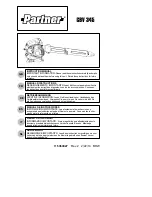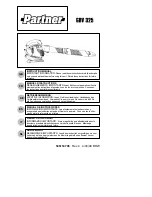
7. Cleaning, maintenance, storage,
transport and ordering of spare
parts
Always switch off the equipment and pull out the
spark boot plug before carrying out any
maintenance work.
7.1 Cleaning
_ Keep all safety devices, air vents and the motor
housing free of dirt and dust as far as possible.
Wipe the equipment with a clean cloth or blow it
with compressed air at low pressure.
_ We recommend that you clean the device
immediately each time you have finished using it.
_ Clean the equipment regularly with a moist cloth
and some soft soap. Do not use cleaning agents
or solvents; these could attack the plastic parts
of the equipment. Ensure that no water can seep
into the device.
VACUUM BAG CLEANING
A dirty bag will obstruct airflow, thereby reducing
vacuum efficiency.
To Clean Bag:
1. Detach vacuum bag from unit.
2. Open zipper and remove contents.
3. Turn bag INSIDE OUT and shake vigorously.
This procedure should be performed on a regular
basis.
4. Turn bag RIGHT SIDE OUT, close zipper and
attach to unit.
NOTE:
If vacuum bag is unusually dirty, it should be
washed by hand in warm water with a mild
detergent.
Rinse thoroughly. Let dry before using.
7.2 Maintenance of the air filter (Fig. 7a-7b)
Soiled air filters reduce the engine output by supply
too little air to the carburetor.
Regular checks are therefore essential. The air filter
should be checked after every 25 hours of use and
cleaned if necessary. If the air contains a lot of dust,
the air filter should be checked more frequently.
1. Remove the air filter cover (Fig. 7a)
2. Remove the filter element (Fig. 7b)
3. Clean the filter element by tapping it or blowing
it.
4. Assemble in reverse order.
Please note:
Never clean the air filter with petrol or
inflammable solvents.
Maintenance of the spark plug (Fig. 8a-8b)
Spark plug gap = 0.6 mm. Tighten the spark plug
with a torque of 12-15 Nm.
Check the spark plug for dirt and grime after 10
hours of operation and if necessary clean it with a
copper wire brush. Thereafter service the spark plug
after every 50 hours of operation.
1. Pull off the spark plug boot (Fig. 8a) by twisting.
2. Remove the spark plug (Fig. 8b) with the
supplied spark plug wrench.
3. Assemble in reverse order.
7.3 Storage
Please note:
If you fail to follow these instructions
correctly, deposits may form on the interior of the
carburettor which may result in the engine being
more difficult to start or the machine suffering
permanent damage.
1. Carry out all the maintenance work.
2. Drain the fuel out of the tank (use a conventional
plastic petrol pump from a DIY store for this
purpose).
3. When the fuel has been drained, start the
engine.
4. Allow the engine to run at idling speed until it
stops. This will clean the remainder of the fuel
out of the carburettor.
5. Leave the machine to cool (approx. 5 minutes).
6. Remove the spark plug.
7. Place a teaspoon full of 2-stroke engine oil into
the combustion chamber. Pull the starter cable
several times carefully to wet the internal
components with the oil. Fit the spark plug again.
8. Clean the exterior housing of the machine.
9. Store the machine in a cold, dry place where it is
out of the reach of ignition sources and
inflammable substances. Fertilizers and other
chemical garden products often contain
substances that accelerate the rate of corrosion
of metals. Do not store the machine on or near
fertilizers or other chemicals.
7.4 Restarting
1. Remove the spark plug.
2. Pull the starter cable several times to clean the
oil residue out of the combustion chamber.
3. Clean the spark plug contacts or fit a new spark
plug.
4. Fill the tank. See the section entitled Fuel and oil.
5. Complete steps 1-7 described under the point
entitled “Starting the engine from cold”.
7.5 Transport
To transport the machine, first empty the petrol tank
as described in section 10 in the section entitled
“Storage”. Clean coarse dirt off the machine with a
brush or hand brush. Dismantle the long handle.
Summary of Contents for GASBT25
Page 3: ......
Page 4: ......
Page 11: ...10 Elimination des erreurs...
Page 18: ...10 Verhelpen van fouten...
Page 25: ...10 Troubleshooting...







































